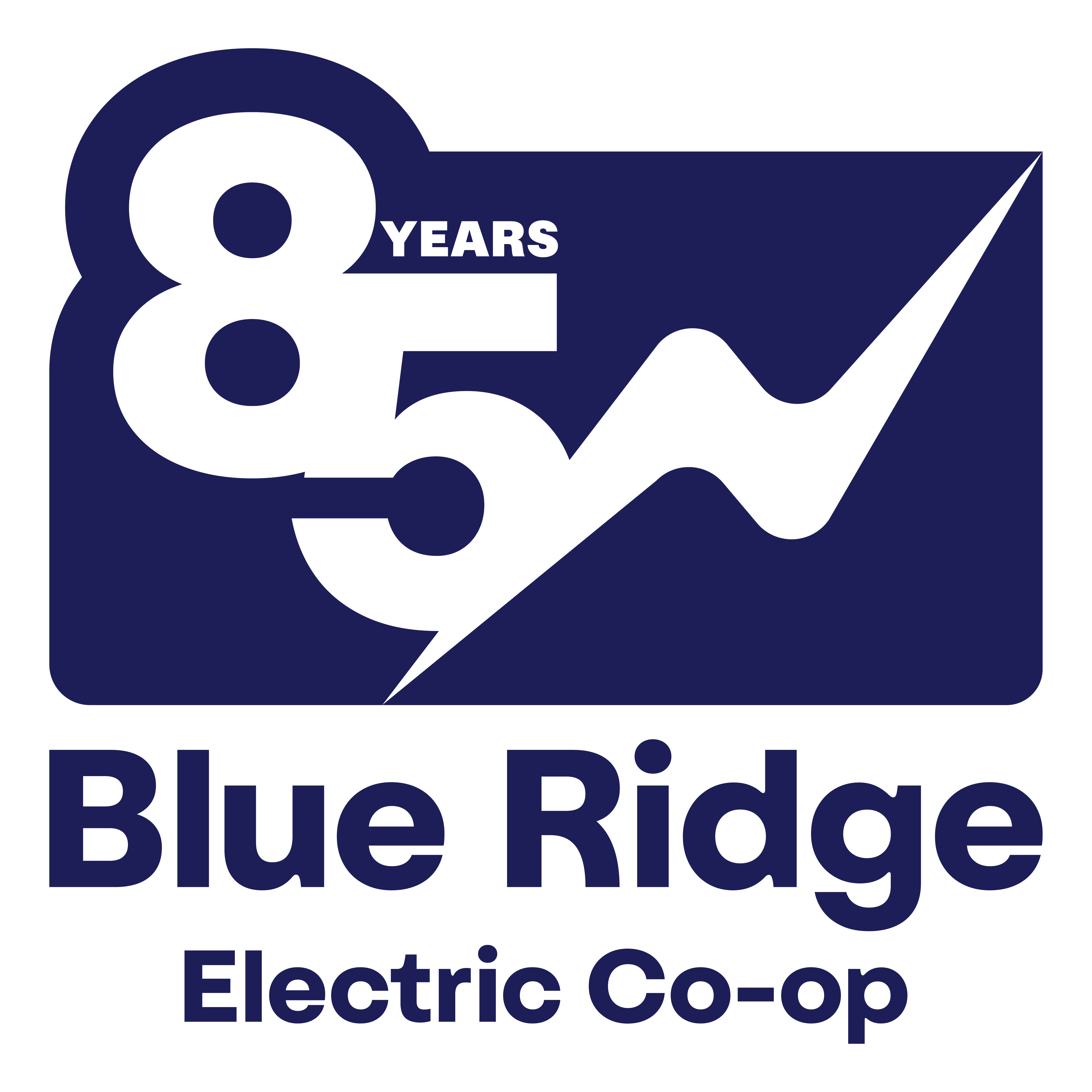About My Bill
We work hard to make sure our members get the most benefit out of being part of the Blue Ridge Electric family. Making sure you understand your electric service and know how to save money each month is a big part of what we do. That’s why we want to make certain you understand all the components of your electric bill.
Below is an interactive version of your monthly bill. Simply click on the orange plus sign for an explanation of each component. If you have questions, we’re here to answer them. Just call us at (800) 240-3400.
If you don't want to use our bill comparison rate calculator, you can calculate your EmPOWERment rate by doing the following:
- Take your total kWh energy usage and multiply it by $0.10443.
- Take your total days of service (typically 30) and multiply it by $1.10 to determine your account charge.
- Take your actual billed peak kW demand and multiply it by $13.
- Add these three figures together to calculate your total bill.*
Calculate your bill on the flat use rate by doing the following:
- Take your total kWh energy usage and multiply it by $0.15219.
- Add this figure to the account service charge of $50 to calculate your total bill.*
*Members can find a monthly power cost adjustment (PCA) that will serve as either a bill credit or charge. The PCA $0.005, effective September 1, 2025.
The power cost adjustment (PCA) reflects the increases or decreases in the cooperative's cost of wholesale power, which Blue Ridge purchases in bulk on behalf of all members. Blue Ridge uses the PCA to adjust your bill to reflect changes in the price the cooperative has to pay for wholesale power it provides to members. By using PCA, the cooperative can keep base rates stable. The PCA can be an extra charge or a credit depending on the cost of wholesale power.
The service charge is a flat fee covering the fixed costs of providing electricity to a member's meter. This charge has always been in bills. It includes costs associated with building and maintaining the distribution system, poles, wires, substations, insurance, property taxes and other operational costs. Our cooperative maintains 7,300 miles of power lines, the most of all 19 cooperatives in the state. You could drive to Anchorage, Alaska, from Pickens and that would still not cover the total number of miles we maintain.
The fee spreads the shared operational costs across all members as fairly as possible, regardless of how much electricity they use. That's why each member pays the service charge each month to cover basic operational costs. All members are charged the same amount for the cost of operational since all members benefit from the same service.
Before understanding how much electricity costs, it's helpful to understand how it's measured. When you buy gas for your car, you're charged by the gallon. When you purchase electricity, you are charged by the kilowatt-hour (kWh). When you use 1,000 watts for 1 hour, that's a kilowatt-hour (kWh). To change watts to kilowatts, divide wattage by 1,000. An electric meter measures both the kilowatts and the time in hours the electricity is being used. The final billing unit is the product of the two measures and this is called a "kilowatt-hour." This is a unit of energy, which measures the total amount of power used or produced over time. Think of this like your car's odometer.
Your peak demand charge is determined by the most amount of kilowatts (kW) used in a single hour of energy use during peak hours. This is a unit of power, which measures the rate at which energy is being used or produced at a given moment. Think of this like your car's speedometer. To save money, avoid having three biggest energy-using appliances in your home (water heater, HVAC and dryer) from running in the same hour during on-peak times. Peak hours are determined by the times when electricity demand is the highest across the entire electric grid. They are not determined by the cooperative. This structure - including the highest single hour of demand - is exactly how Blue Ridge Electric Cooperative is billed by power generators.
Blue Ridge Electric Cooperative does not set peak demand window hours. These are set by power generators at times when the grid is the most strained.
The U.S. Energy Information Adminstration (EIA) estimated in 2020 that more than half of household annual energy consumption is for just two energy end uses: Space heating and air conditioning. Water heating accounts for 19 percent, lighting for 5 percent, refrigeration for 3 percent and all other uses at 21 percent. The residential sector accounts for 21 percent of total U.S. energy consumption, according to the U.S. Department of Energy's Office of Energy Efficiency and Renewable Energy.
Household appliance wattage varies, but a ceiling fan running for an hour should use about 85 watts, or 0.085 kW. Comprehensive lists of items like your air conditioner or ceiling fan can be found here.
This is a natural question when there is a fluctuation in your bill. But remember, no month is the same as the previous or the next. Electrical costs will vary with seasonal use — more electricity is used during the summer and winter than in the fall and spring. Increased electrical usage will fluctuate due to air conditioners, fans, dehumidifiers, electric water heaters, home heating and home entertainment during the holidays. Weather plays an important role in your monthly bill. Seasonal heating or cooling of your home, as well as snow, sun, wind and other weather-related factors, affect your billing costs. Have your heating and cooling systems periodically checked by a certified technician to ensure they are properly working. Malfunctioning systems can cause noticeable changes to your electric bill. If your energy usage is greater than normal, check your bills for days of service.
